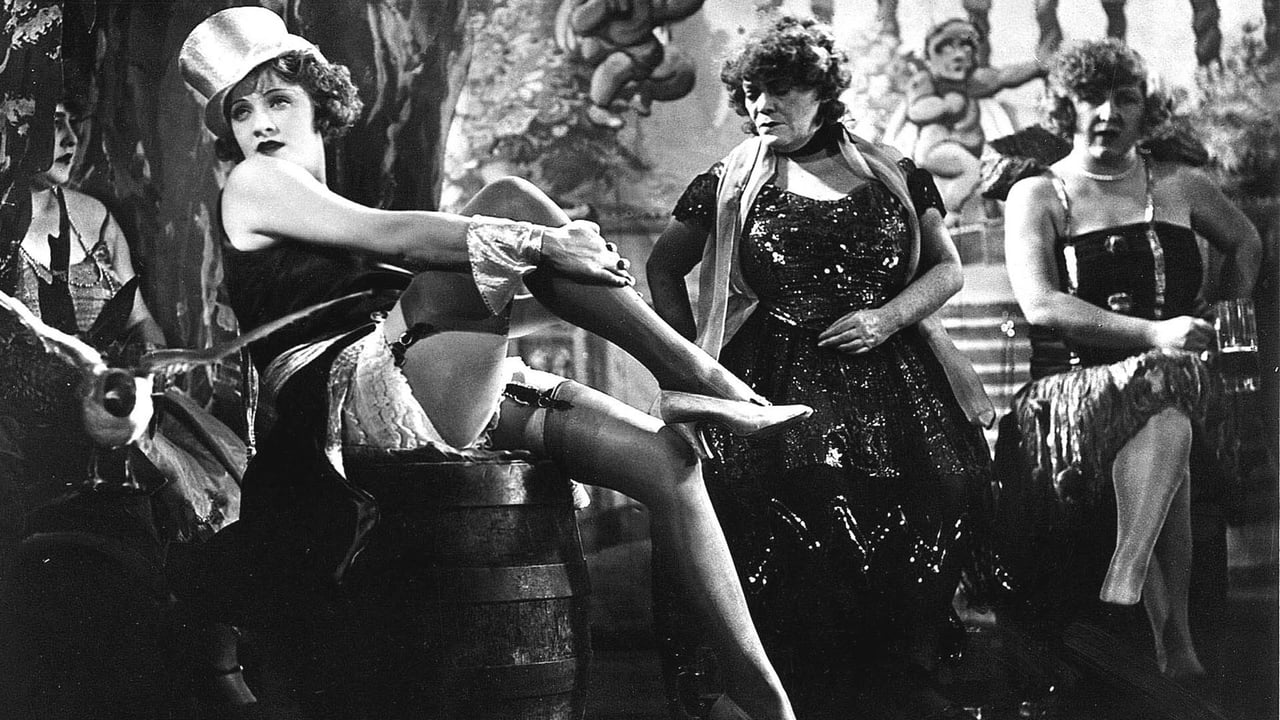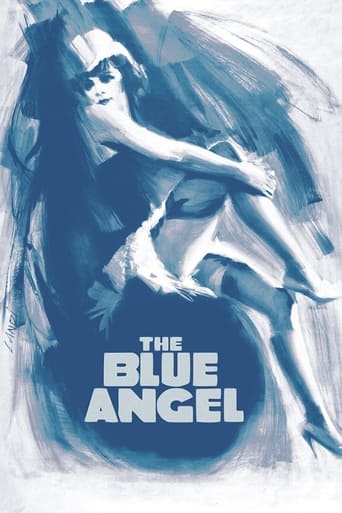

"The Blue Angel" from 1930 made a star out of Marlene Dietrich and has a great performance by Emil Jannings. It's a very dark tale of obsession leading to degradation.The film is based on a novel by Heinrich Mann directed by Josef von Sternberg. It concerns a professor (Jannings) who goes to a club, The Blue Angel, where he learns his students go, and meets the hypnotic Lola (Dietrich). He falls in love with her, marries her, and starts down a road that leads to hell.This is a movie about images -- a dead bird, the magnificent Lola, Jannings as a clown, his descent into madness, his image in a mirror, and the final shot of him, utterly destroyed, at his old professor desk.This is German filmmaking at its best. Von Sternberg and Dietrich would head for America; Jannings, a Nazi collaborator, would stay put. Later Dietrich called him a "ham." He does give a big performance, but somehow, it isn't over the top. On a side note - Jannings was the winner of the first Academy Award, but in reality, he placed second. The winner? Rin Tin Tin. The Academy believed it wouldn't put them in a good light to give the award to a dog, so they denied Rin his award and gave it to Jannings instead. It's said he used to carry it with him.
... View MoreOK. I'm just guessing here - But judging by The Blue Angel's decidedly wacky, off-kilter storyline, I'm pretty convinced that this German import from 1930 was supposed to be director Josef Von Sternberg's idea (as lame as it was) of a Hollywood-style "Screwball" comedy.I mean, being a "Screwball" comedy is the only thing that explains so much about this film's nonsensical idiocy. 'Cause I could never, ever take the utter inanity that went on in The Blue Angel's story at all seriously.If this film was intended as a dead-serious drama, it sure came across as being downright laughable to me. And I'd say that anybody who does take this film with a straight face is setting themselves up for a major disappointment, if you ask me.At first I actually thought I was in for a real cinematic treat with The Blue Angel - But, alas, even the sluttified, 29-year-old Marlene Dietrich with her plump butt and chubby legs lost their overall appeal even before I realized what was happening.... And, what would I say about Dietrich's singing!!??.... Oh, man, I don't even wanna get started on that! In many ways, The Blue Angel reminded me, more than anything else, of a poorly-choreographed, live-action cartoon. And actor Emil Jannings (the future Nazi-lover) was absolutely despicable in this film as the lecherous, old fart, Professor Rath.
... View MoreTHE BLUE ANGEL may have a hackneyed, quasi-melodramatic plot, but it is quite simply brilliant nonetheless. In her debut feature, Marlene Dietrich is both sexy and dominant; photographed in a variety of states of déshabillée by Von Sternberg, she come across as someone with an instinctive feel for the camera. Her songs are beautifully delivered, and her sheer presence within the frame is a delight. Emil Jannings is equally memorable as the gulled professor; in a film showing its origins in silent movies, he has a range of gestures and eye-work that are tremendously funny, especially in those sequences where he tries to keep his class of unruly students quiet, or when he tries yet fails to suppress his amorous feelings for Lola (Dietrich). The film's ending is both shocking and yet poignant, showing the depths to which humankind can be reduced once love gets in the way. When the Professor chases Lola for the final time, uttering the unearthly screams of a cockerel, we feel genuinely concerned for her safety. As with most UFA films of this period, THE BLUE ANGEL is distinguished by atmospheric lighting and use of shadows, especially in its portrayal of the seedy back-streets where the Blue Angel club is situated. Definitely a classic of its kind that stands up really well after eight decades.
... View MoreWE CAN WELL recall viewing this film for the very first time on a PBS Friday evening show. This was circa 1971 and we needed to go to such Public Television stations as our own WTTW, Channel 11 in Chicago in order to see many films which weren't shown on commercial TV Statiobs.WELL, HOW THINGS have changed. Just this passed Monday (2 days ago), Turner Classic Movies ran THE BLUE ANGEL in prime-time. It had been about 40 years (yes, count 'em, folks!) since our initial contact with Herr Josef Von Sternberg's dark, tragic drama. We had seen it once or twice during that period, but had never given it my undivided attention.ALTHOUGH IT IS a German language film, there was at least one of these showings was in a recently rediscovered English language version. We also remember a showing which was in German; but featured Miss Dietrich's performance of "Falling In Lov Again" in English.VIEWING A FILM SUCH as this very talky drama, while at the same time being compelled to read Subtutles, in order to follow the story can really prove to be a pain right where one sits. Yet, it does seem to become easier as the story progresses; as we become engrossed with the scenario unfolding, the dark yet starkly penetrating images, moody and highly atmospheric songs & music and the virtuoso acting performances.THE STORY MAY seem somewhat complex; yet it is probably the very universal themes and connection with the lives and needs of all people that make this such a powerful and compelling of a story with such a long life as an all time favourite.IN SHORT, WE have a story of loneliness, the need to love and be loved, the falling from grace of a highly regarded and most straight laced of a member of academia. From perhaps a most distinguished position and and outstanding of a reputation as a Professor of Literature at the unnamed university, the professor (Mr. Emil Jannings) falls in love with a common, vulgar cabaret singer and exponent of sex, Lola Lola (Miss Marlena Dietrich).THE STORY COVERS a period of over five years, in which the middle aged, clearly un-handsome man discovers that he has fallen to such a degree of degradation as to not only being a minor entertainer; but also participating in selling his own wife. During appearances following Lola's doing her song, professor Roth's duties included peddling some rather pornographic type of postcards to the bawdy male patrons of the show.WE MUST CONFESS that even being a grown man, married with two children, there was an awful lot of obvious seedy goings on that I missed on previous viewings. Certainly, there were no examples of explicit on screen sex (such as have become so commonplace); and yet, with all of the occurrences we surely are forced to ask a few questions.IN ADDITION TO the setting of a night club with rather risqué programming, what is it that all of these college boys find so fascinating? Why do the young men hide from the Professor in secret rooms that are below the floors? What is the purpose of these rooms? Why does the proprietor worry about the presence of a police officer; for, isn't this a legal and licensed establishment? Do you think that there is sex for sale here? We do.THE AMAZING FEAT that is accomplished here is making such an interesting story out of such a sordid and low life segment of society.WE GIVE THIS five stars as our rating.
... View More